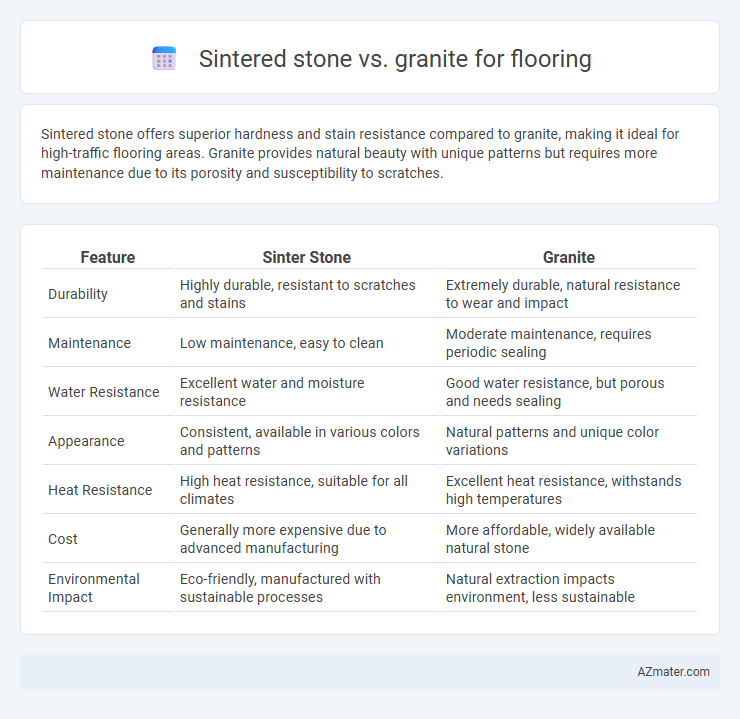Sintered stone offers superior hardness and stain resistance compared to granite, making it ideal for high-traffic flooring areas. Granite provides natural beauty with unique patterns but requires more maintenance due to its porosity and susceptibility to scratches.
Table of Comparison
| Feature | Sinter Stone | Granite |
|---|---|---|
| Durability | Highly durable, resistant to scratches and stains | Extremely durable, natural resistance to wear and impact |
| Maintenance | Low maintenance, easy to clean | Moderate maintenance, requires periodic sealing |
| Water Resistance | Excellent water and moisture resistance | Good water resistance, but porous and needs sealing |
| Appearance | Consistent, available in various colors and patterns | Natural patterns and unique color variations |
| Heat Resistance | High heat resistance, suitable for all climates | Excellent heat resistance, withstands high temperatures |
| Cost | Generally more expensive due to advanced manufacturing | More affordable, widely available natural stone |
| Environmental Impact | Eco-friendly, manufactured with sustainable processes | Natural extraction impacts environment, less sustainable |
Introduction to Sinter Stone and Granite Flooring
Sinter stone, a dense and durable engineered material formed through sintering technology, offers enhanced strength and resistance to scratches and stains, making it ideal for high-traffic flooring areas. Granite, a natural igneous rock renowned for its unique patterns and long-lasting durability, provides a timeless and elegant aesthetic often used in both residential and commercial flooring. Both materials deliver robust performance and aesthetic appeal, but sinter stone generally requires less maintenance compared to granite's porous nature.
Material Composition: Sinter Stone vs Granite
Sinter stone is an engineered material composed primarily of natural quartz, feldspar, and other minerals fused under high heat and pressure, resulting in a highly dense and non-porous surface. Granite, a natural igneous rock, consists mainly of quartz, feldspar, and mica with a crystalline structure formed through slow cooling of magma. The synthetic composition of sinter stone enhances its resistance to staining and scratching compared to granite's natural variability in hardness and porosity, influencing durability and maintenance in flooring applications.
Durability and Strength Comparison
Sintered stone offers exceptional durability with high resistance to scratches, stains, and heat, making it ideal for high-traffic flooring areas. Granite is also highly durable and strong, known for its natural hardness and ability to withstand heavy impact and pressure over time. While granite requires sealing to maintain its strength and appearance, sintered stone is virtually maintenance-free and resistant to fading and wear.
Aesthetic Appeal and Design Options
Sinter stone offers a sleek, uniform surface with modern, minimalist aesthetics, while granite showcases unique natural patterns and rich color variations that enhance traditional and luxurious designs. Both materials provide a wide array of finishes, but sinter stone excels in large-format slabs with consistent tones, ideal for contemporary interiors. Granite's organic textures and diverse mineral patterns allow for intricate, natural visual effects that enrich classic and rustic decor themes.
Installation Process and Requirements
Sinter stone flooring requires precise cutting and specialized tools due to its ultra-dense composition, often necessitating professional installation to prevent cracking and ensure seamless joints. Granite installation demands thorough substrate preparation and the use of heavy-duty adhesives or mortar to accommodate its natural weight and reduce the risk of uneven surfaces. Both materials benefit from expert grout application and sealing to enhance durability and maintain aesthetic appeal in high-traffic areas.
Maintenance and Cleaning Needs
Sinter stone flooring offers superior stain resistance and requires minimal maintenance compared to granite, as its non-porous surface prevents dirt and liquids from penetrating. Granite floors need regular sealing to maintain their durability and prevent stains, making them more high-maintenance over time. Both materials benefit from routine cleaning with pH-neutral cleaners, but sinter stone's low porosity significantly reduces the risk of mold and grime buildup.
Stain and Scratch Resistance
Sintered stone exhibits superior stain and scratch resistance compared to granite due to its non-porous surface formed under high pressure and temperature, making it highly durable and low-maintenance. Granite, although naturally hard and durable, can be more prone to staining and scratching over time without proper sealing and care. Choosing sintered stone flooring offers enhanced longevity and easier upkeep in high-traffic or spill-prone areas.
Cost Analysis: Sinter Stone vs Granite
Sinter stone flooring typically costs between $30 to $60 per square foot, offering a more budget-friendly alternative compared to granite, which ranges from $40 to $100 per square foot depending on quality and source. Installation costs for both materials are comparable, but granite may require additional expenses for sealing and maintenance due to its porous nature. Over time, sinter stone can reduce total cost of ownership thanks to its durability and lower maintenance requirements compared to granite.
Environmental Impact and Sustainability
Sinter stone offers a more sustainable flooring option than granite due to its lower extraction impact and energy-efficient manufacturing process, which reduces carbon emissions significantly. Granite mining leads to habitat disruption and high water consumption, while sinter stone uses recycled materials and produces less waste. Choosing sinter stone helps minimize environmental degradation and promotes eco-friendly construction practices in flooring projects.
Which Flooring is Best for Your Space?
Sinter stone offers superior stain resistance and low porosity compared to granite, making it ideal for high-traffic or moisture-prone areas. Granite flooring boasts exceptional durability and natural beauty with unique veining patterns, suitable for both indoor and outdoor spaces. Choosing the best flooring depends on your space's specific needs, balancing aesthetics, maintenance, and durability requirements.

Infographic: Sinter stone vs Granite for Flooring
 azmater.com
azmater.com